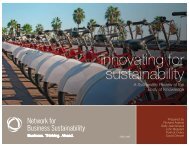embedding sustainability in organizational culture - Network for ...
embedding sustainability in organizational culture - Network for ...
embedding sustainability in organizational culture - Network for ...
Create successful ePaper yourself
Turn your PDF publications into a flip-book with our unique Google optimized e-Paper software.
appeNdIx Chapter 1: a: Introduction Methodology<br />
63<br />
search source <strong>in</strong>itial<br />
search<br />
prelim<strong>in</strong>ary<br />
screen<strong>in</strong>g<br />
reta<strong>in</strong>ed<br />
analogous Interventions 2710 115 83**<br />
embed* and Culture 687 25 15<br />
Innovat* and Culture 635 28 23<br />
Compl* and Culture 284 21 18<br />
Safety and Culture 384 21 21<br />
eMS/environmental management system*<br />
and Culture<br />
600 5 2<br />
high reliability organization and Culture 64 7 6<br />
tQM /total quality management and Culture 56 8 8<br />
total 13756 701 179<br />
** Unique document count (s<strong>in</strong>ce some documents arose from multiple search<br />
terms). In the f<strong>in</strong>al column, the documents are recorded <strong>in</strong> the first search <strong>in</strong> which<br />
they appeared.<br />
The f<strong>in</strong>al screen<strong>in</strong>g reta<strong>in</strong>ed a total of 179 sources <strong>in</strong>clud<strong>in</strong>g 82 academic sources<br />
related to <strong>susta<strong>in</strong>ability</strong>, 83 sources related to analogous cultural <strong>in</strong>terventions, 10<br />
books and 4 practitioner reports. A complete reference list <strong>for</strong> the f<strong>in</strong>al document set<br />
is provided <strong>in</strong> Appendix B.<br />
data extraction<br />
Our data sources were then loaded <strong>in</strong>to a qualitative analysis program called Atlas.ti.<br />
Atlas.ti (2010) was selected <strong>for</strong> this purpose due to its ability to handle large bodies<br />
of data (and <strong>in</strong> particular, PDFS) along with the tools it provides to help arrange,<br />
reassemble, and manage these materials <strong>in</strong> systematic ways. The use of a qualitative<br />
analysis program was <strong>in</strong>strumental <strong>in</strong> handl<strong>in</strong>g a data set this large by support<strong>in</strong>g<br />
the analysis process and by permitt<strong>in</strong>g us to organize and query our f<strong>in</strong>d<strong>in</strong>gs.<br />
Our next task was to extract the relevant <strong>in</strong><strong>for</strong>mation from each of the sources.<br />
We did this through a process of ‘cod<strong>in</strong>g.’ Open cod<strong>in</strong>g <strong>in</strong>volves “break<strong>in</strong>g down,<br />
exam<strong>in</strong><strong>in</strong>g, compar<strong>in</strong>g, conceptualiz<strong>in</strong>g, and categoriz<strong>in</strong>g data” (Strauss & Corb<strong>in</strong>,<br />
1990: 61). Cod<strong>in</strong>g <strong>in</strong>volves select<strong>in</strong>g part of the text (a ‘quotation’) and attach<strong>in</strong>g a<br />
label or tag (a ‘code’) to that text. It also <strong>in</strong>volves a process of constantly compar<strong>in</strong>g<br />
<strong>in</strong>cidents to each other <strong>in</strong> the data (Holton, 2007). It is a highly systematic and<br />
iterative process that <strong>for</strong>med the foundation of our analysis. We coded each and<br />
every source by ask<strong>in</strong>g ourselves the follow<strong>in</strong>g questions:<br />
What are they do<strong>in</strong>g?: We coded every <strong>in</strong>stance where we found an<br />
<strong>organizational</strong> practice that aimed to embed <strong>susta<strong>in</strong>ability</strong> <strong>in</strong> <strong>organizational</strong> <strong>culture</strong>.<br />
In nam<strong>in</strong>g our codes, we made use of gerunds (words end<strong>in</strong>g <strong>in</strong> ‘<strong>in</strong>g’) to capture<br />
what the organizations were ‘do<strong>in</strong>g.’<br />
Who is do<strong>in</strong>g it?: Initially, our aim was also to capture ‘who’ with<strong>in</strong> the<br />
organization was undertak<strong>in</strong>g the practice (<strong>for</strong> example, the human resources<br />
department, the CEO, the Board of Directors, management, or employees). We<br />
found it was often difficult to identify based on the <strong>in</strong><strong>for</strong>mation provided <strong>in</strong> the<br />
articles, and that practices often straddled multiple groups. While we cont<strong>in</strong>ued to<br />
attempt to code the data <strong>in</strong> this way, <strong>in</strong> the end, we did not make use of these codes<br />
<strong>in</strong> our analysis.<br />
Why are they do<strong>in</strong>g it?: For each practice, we asked ourselves, why are they<br />
do<strong>in</strong>g this… what is their goal? Initially we coded openly, mak<strong>in</strong>g use of codes such<br />
as: ‘they said they would;’ comply; and improve. By compar<strong>in</strong>g the properties of<br />
these codes, we began to group them <strong>in</strong>to two categories of goals: fulfillment and<br />
<strong>in</strong>novation.
















